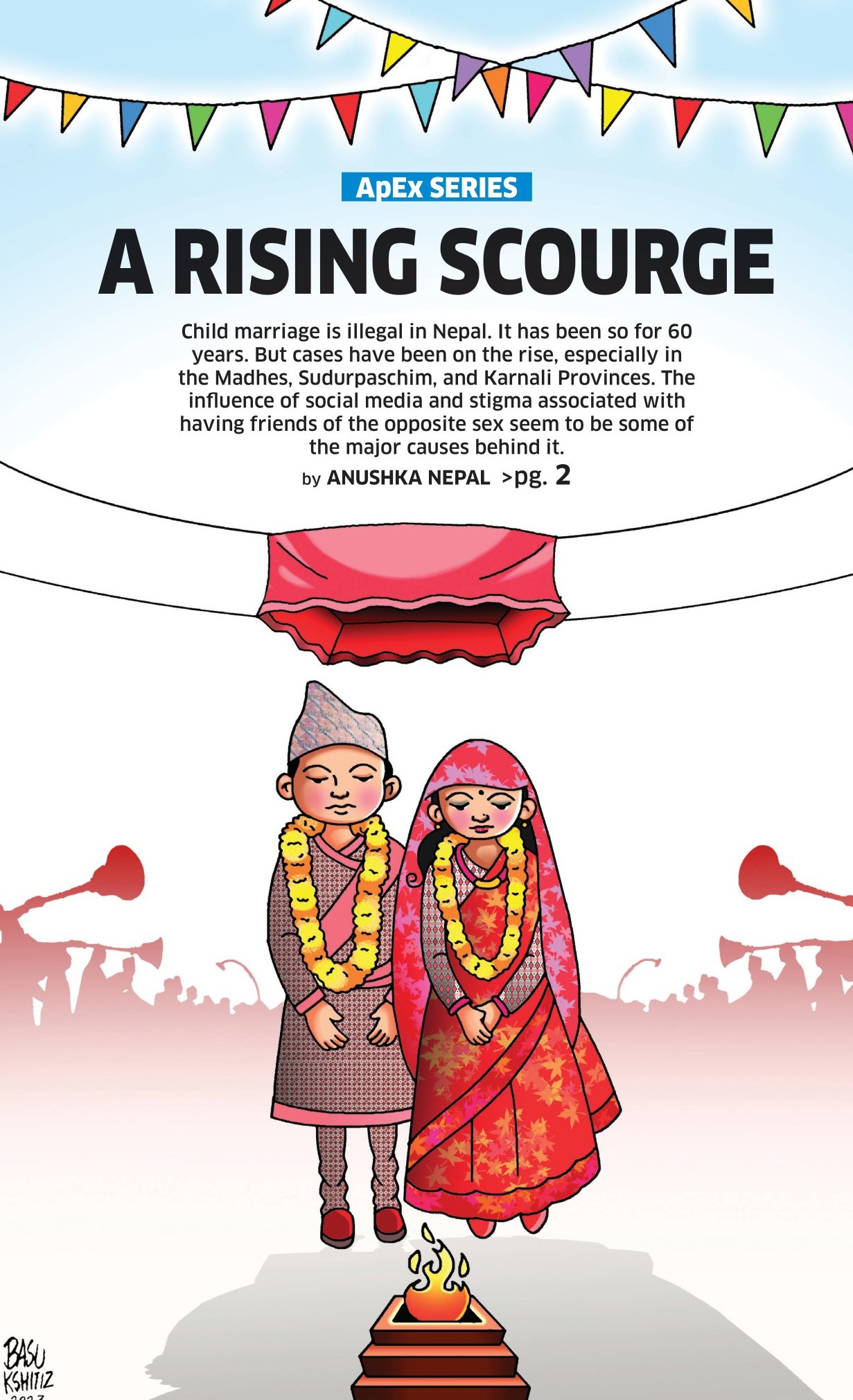Child marriage has been illegal in Nepal since 1963. Both parties must be at least 20 years or above to get married. Despite this, in many parts of Nepal, underage marriage is still the norm.
Kumar Bhattarai, program director at Child Workers in Nepal (CWIN), says child marriage has only been increasing in Nepal. “Around a decade ago, most children would get married because of family pressure. That’s not the case now,” he says. In most cases of child marriages that CWIN has come across, it’s the children who have decided to get married, with some even eloping when their parents refused to accept the relationship.
The number rose during the Covid-19 pandemic, says Dharma Raj Tharu, Bardiya district coordinator for Aawaaj, an organization actively working against child marriage. According to a report—Adapting to Covid-19—published by the United Nations in Sep 2020, the reason behind the rise in child marriages during the lockdown was mainly the closing of schools and loss of livelihoods.
“As most families were bankrupt, marrying off their children was one way of reducing their expenses,” he says. Nirjana Bhatta, national coordinator of Girls not Brides-Nepal, a network of organizations working to prevent child marriage, agrees with Bhattarai and Tharu. She further adds that child marriages are rampant in the Madhesh, Sudurpaschim, and Karnali Provinces of Nepal. One of the many reasons, Bhatta believes, behind the increase in the number of underage marriages, is the influence of social media.
“During the teenage phase, most people need someone to confide in. They need a support system. When parents fail to provide that, they seek comfort from someone else through social media,” she says. This usually results in love affairs, which in turn leads to marriage (and/or elopement). Bhatta claims some parents allow their underage children to get married fearing they will otherwise elope. Many parents are still looking for their children who have eloped and never returned. Most of them, Tharu says, flee to India to get married when their families try to separate them. It’s mainly common in the Tarai belt where the Nepal-India border is easily accessible. “This mostly happens in case of intercaste marriages or when two families come from different economic backgrounds,” he says.
Then there’s also the fact that any form of relationship between a boy and a girl is generally frowned upon in our society, more so in rural areas. This has also forced youths to get married before they are legally allowed to. Nisha Paudel, Surkhet district coordinator for Aawaaj, says, families aside, even schools have made it difficult for children to be friends with the opposite sex. With teasing from classmates, parents questioning their relationship, and teachers inquiring if they are planning to get married, children are forced to believe that marriage is the only way they can stay close to someone they care about. “Most of the time, parents force children, especially girls, to get married because they fear people will speak ill of them otherwise, for having a relationship that’s not validated through marriage,” she says.
According to Paudel, most children getting married in Karnali Province are between the ages of 14 to 19. This taboo and stigmatization of any relationship outside of marriage, Bhattarai believes, has also led to children not being able to have an open conversation about infatuation and physical relationships. “Children, because of easy access to the internet, come across a lot of adult content. To cater to that curiosity, many children decide to marry early,” he says. The curiosity is also fueled by the lack of privacy within the household.
In some of the incidents CWIN has encountered, children have confessed to seeing their parents having sex. “Learning more about this only adds to their desires, and they think marriage is the only way to fulfill that,” he says. Another reason for getting married early seems to be to get out of domestic violence or sexual abuse within their household. “Most children say they would rather have a physical relationship with their husbands than be abused daily by their relatives,” says Bhattarai.
According to Nepal Police, in the 10 months of the fiscal year 2022/23, 26 cases of child marriage have been reported. Similarly, 52, 84, and 64 complaints were registered in the fiscal year 2021/22, 2020/21, and 2019/20 respectively. Although the data shows a decline in the number of child marriages, Poshraj Pokharel, spokesperson of the Nepal Police, says most cases don’t reach the police.
“The media has also failed to shine a light on this issue,” adds Bhattarai. He believes child marriage is on the rise but data says otherwise because of underreporting of cases. Kamala Bist, Baitadi district coordinator for Yuwalaya, an organization working for child rights in Nepal, says parents usually allow their children to get married if the person they choose to marry matches their caste and economic status. This is also one of the major reasons for underreporting of child marriages. The cases that do get reported are when the marriages are inter-caste.
“Because our society still believes in the caste system, families aren’t reluctant to file a complaint in such cases,” says Bist. But the nature of the complaints takes a different turn when children are willing to get married without their parent’s approval. Sagar Bhandari from CWIN’s helpline says that parents, mostly from the girls’ side, try to file a rape case to prevent the marriage. “There are cases where boys have been falsely accused and sentenced too,” he says. The outcome of child marriage is grave.
Children are deprived of education, become victims of domestic violence, and bear children at a young age. In most cases, girls are abandoned by their husbands and in-laws once she gives birth. “These children don’t have anywhere to go since their own families won’t accept them anymore,” says Paudel. Worse, the cycle often repeats with the offspring following in their parent’s footsteps.











